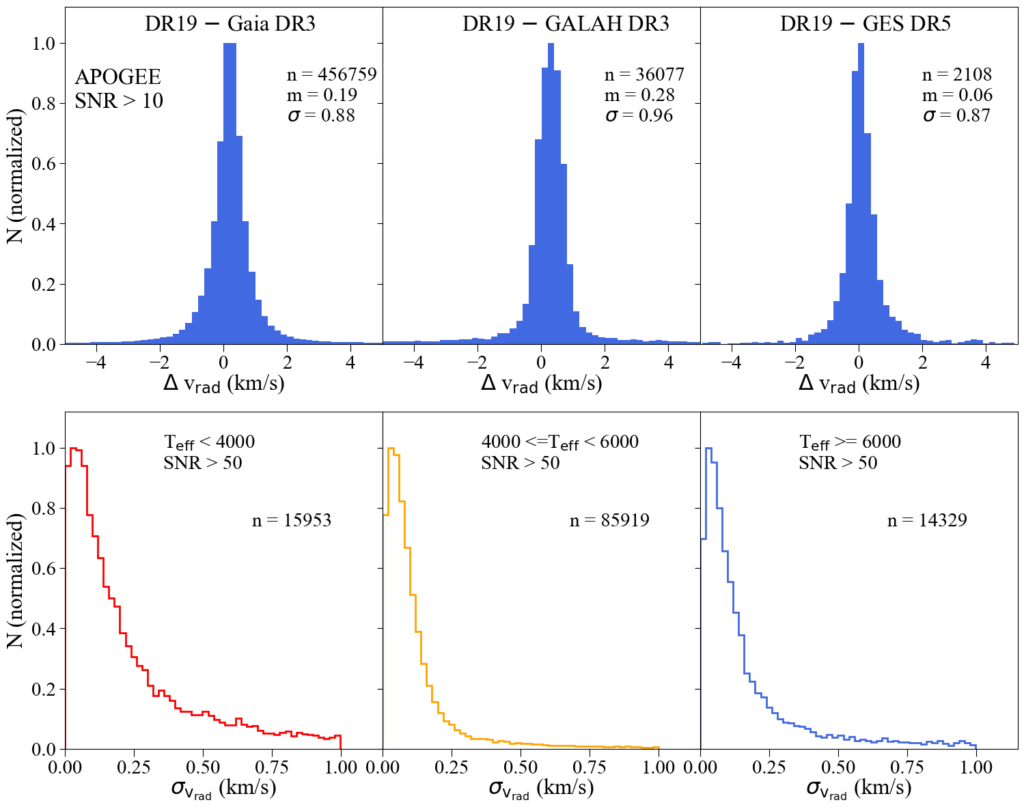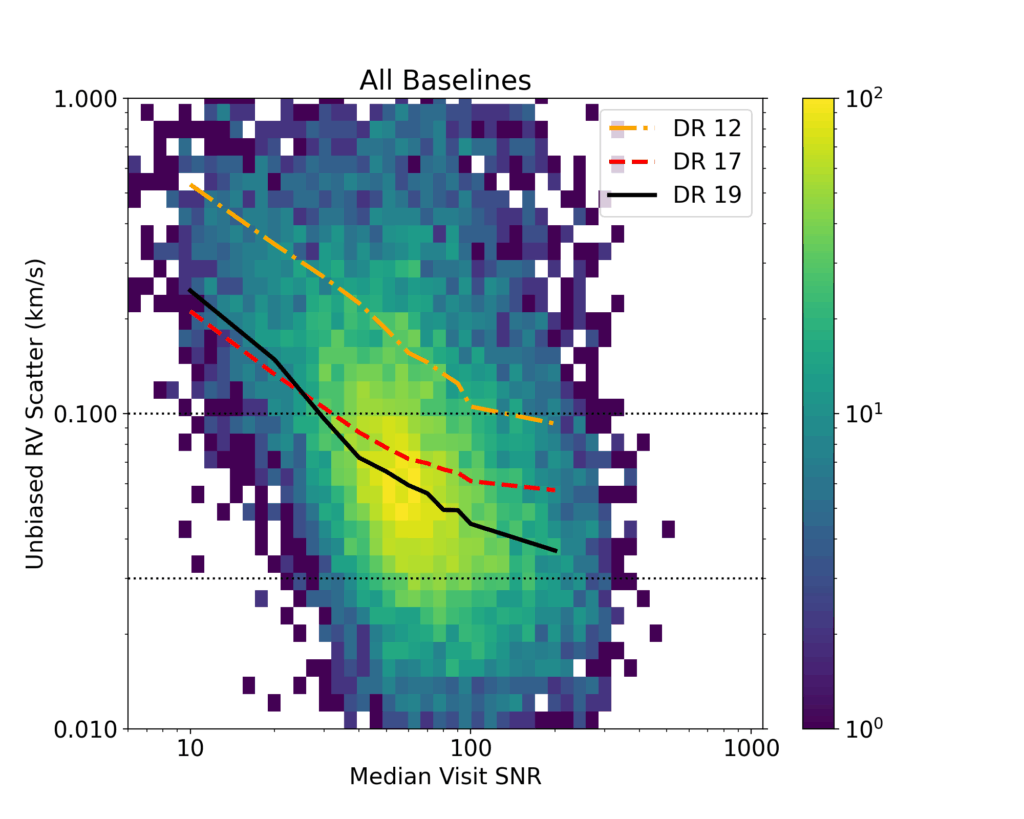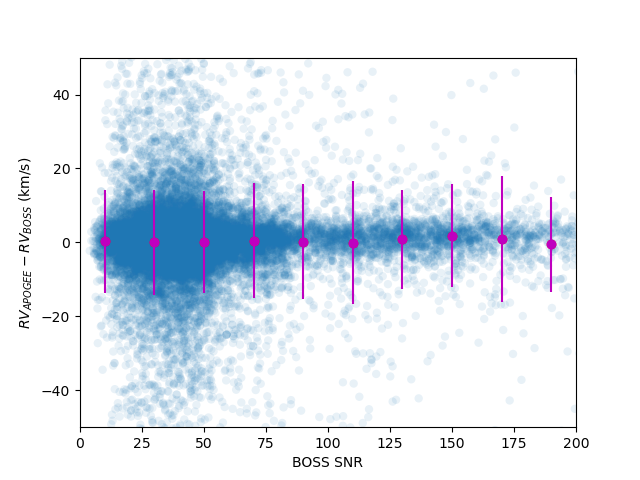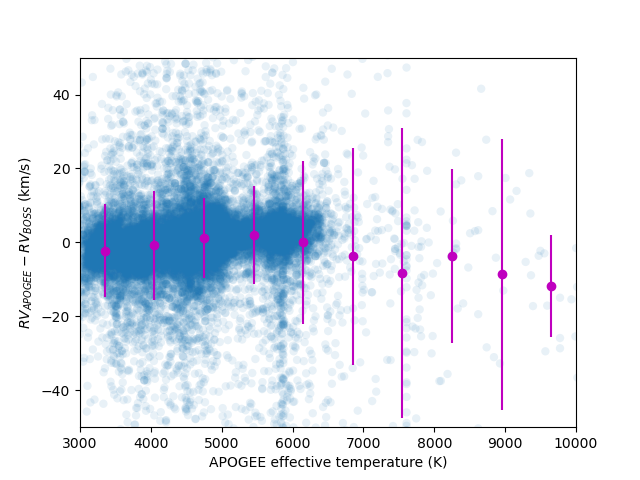Overview
The barycentric radial velocities are called v_rad in the Astra summary files

SDSS-V determines radial velocities for stars from both APOGEE and BOSS spectra. Not only are radial velocities valuable information about stellar motions, but it is necessary to correct for the radial velocity shifts due to the Earth’s motion and any binary motion to correctly stack the spectra at rest wavelength. The fits to the synthetic spectral grids are done at rest wavelength.
In SDSS-V, as in all previous SDSS, the wavelengths are in vacuum
APOGEE RVs with Doppler
Radial velocities for the APOGEE spectra are determined by Doppler as part of the APOGEE Data Reduction Pipeline.
General RV accuracy
First we consider the bulk RV accuracy of APOGEE spectra across all observations from SDSS-III, -IV and -V. Figure 1 shows the comparison with RVs from Gaia DR3, GALAH DR3 and GES DR5 to evaluate the zero point accuracy of the RV (Mészáros et al. 2025), which is better than 0.5 km/s. The precision of radial velocities can be estimated by examining the scatter of derived radial velocities in stars with multiple visits. The histogram of this scatter for the APOGEE spectrograph is shown in the bottom panels of Figure 1 as a function of Teff. The precision of the DR19 vrad values is excellent, peaking at around 70 m/s when considering spectra with SNR>50 and temperatures below 8000 K.

High Precision RVs
For high signal-to-noise data for F stars and cooler, APOGEE spectra can yield highly precise RV measurements. Saydjari et al. (2025) reduced the APOGEE data with a new algorithm (apMADGICS), which models all components of the spectrum simultaneously, and showed that 30m/s precision is achieveable for DR17 APOGEE data when the star is observed through the same fiber. Often the stars are not observed with the same fiber, especially stars observed over months or years, so it is advantageous to achieve this level of accuracy across all fibers.
With the installation of the focal plane system (FPS), the APOGEE spectrograph was upgraded with octagonal fibers and a Fabry-Perot system to improve the stability of the RV solution.

To examine the RV stability in SDSS-V, we identified stars in the allStar file that had a minimum of 3 ngoodvisits, taken in the FPS era (after MJD 59550), and starflag = 0. The stars were further selected down to have the following stellar characteristics: an Teff < 6250K, log g> 1.5, and unbiased vscatter < 1.0 km/s. These criteria limit the sample to stars with reasonably narrow lines, with small astrophysical RV jitter, and without obvious binary signatures respectively. One complication of this analysis is that the stars in our sample had a wide variety of number of epochs, so comparing the standard deviations (vscatter) from star to star can give artificially low values of velocity scatter for stars with small numbers of epochs. To correct for this problem, we used the c4 parameter from Holtzman (1950) to normalize the vscatter column from the allStar file. The resulting velocity scatter is referred to going forward as the unbiased vscatter. The median visit signal to noise was calculated for each star and then plotted with a 2-dimensional histogram in Figure 2. DR 19 shows a significant improvement from DR 12 and DR 17 with a minimum unbiased RV scatter of approximately 41 m/s. This puts us within reach of our final goal of 30 m/s, and we anticipate new techniques will continue this improvement.
BOSS RVs with XCSAO
In DR19, MWM stellar RVs are determined by xcsao (Kounkel 2022), which is based the IRAF task of the same name. This replaces the ELODIE catalog of templates with a more extensive set of templates to ensure good RV across a wide range of temperatures.
We can estimate the accuracy of xcsao RVs by comparing BOSS xcsao RVs and APOGEE Doppler RVs for stars that have been observed with both instruments. We limited our sample to stars with BOSS SNR > 10 and reported vrad errors < 30 km/s for xcsao and and < 10 km/s for Doppler. We implemented one round of 3-σ clipping, which was necessary because there are some large outliers, where the BOSS and APOGEE RVs disagree by > 100 km/s. We are currently investigating the sources of the discrepancies, but we urge caution when a large difference is found, as the cause is likely a data-processing error, rather than the discovery of the most interesting object in the known Universe.

Figure 3 shows the comparison of xcsao vs. Doppler as a function of SNR, while Figure 4 shows the comparison as a function of Teff. Overall, the xcsao RVs show excellent agreement in zero point. The σ=14.2 km/s, which is therefore the xcsao uncertainty, given the accuracy of the Doppler RVs. Figures 3 and 4 also show that smaller uncertainties can be obtained in parts of parameter space (e.g., cooler stars), and users are urged to evaluate the uncertainties of their sample via a similar technique.

We recommend the xcsao RVs for all MWM stars with the exception of white dwarfs, which we turn to next.
White Dwarf RVs with CORV
corv (Chandra et al. 2023) is a customized pipeline to get accurate RVs for DA white dwarfs. It is run as part of Astra (Casey et al. 2025) using the BOSS spectra as input. Therefore, unlike xcsao, corv RVs are not part of the BOSS summary files. Please see the corv page for more details. corv achieves 14 km/s accuracy at SNR > 10 for the DA white dwarfs.
To get the corv RVs, you need to use the astraAlllVisitCORV file.
